I would like to share a report from the above mentioned event due to its contents is as current now as to when the seminar was run in December 1995 in London, England hence I am sharing with you all. The Instructors on the course were Tomiko Mitsuoka Sensei 8th Dan WSKF International Director and Dr Steven Bellamy Professional Sports Coach. The course was scheduled for three hours with a 15min break half way through. It was attended by over 40 students from the local clubs in area, the theme of the seminar was “The race for perfection has no finish line” hence to keep an open mind and to never stop training and learning and we should not think that we have learned it all.
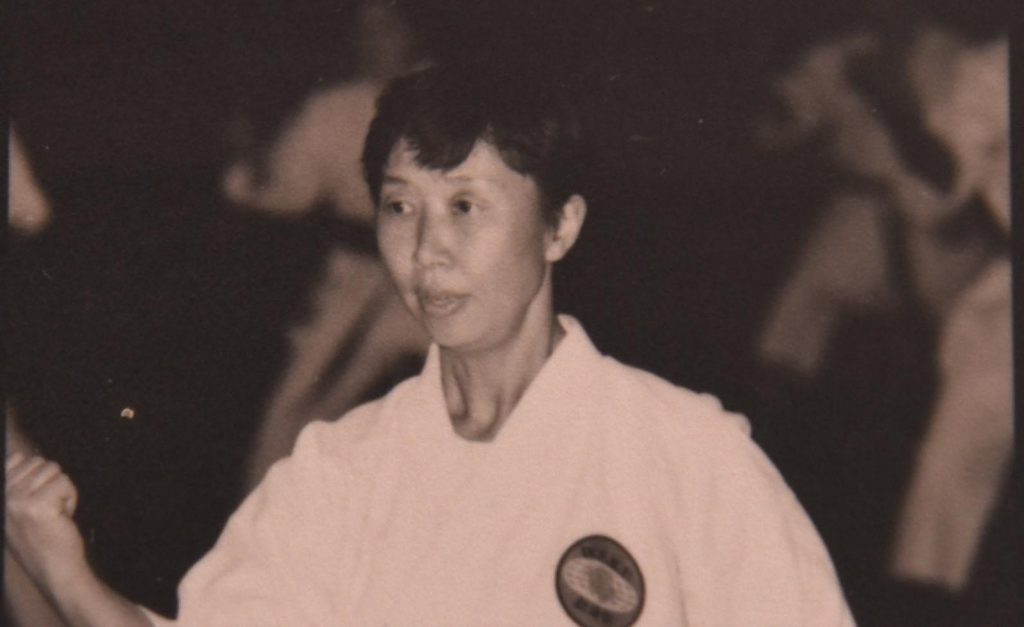
The course was started with the introduction of the instructors. Then we went straight into warm up which was conducted by Dr Steven Bellamy with a lecture while we were warming up. He explained that the reason for a warm up was to raise the heart rate, and to warm up the muscles in preparation for the next activities, the method that he instructed was the interval training style, that is Hard and Soft. Fast and Slow, correct warm should not last more than 10mins, most training accidents occur during the warm up and not during the practice of your chosen sport. Dr Steven Bellamy’s warm up consisted of the following in this order, each module lasted less than 2mins, we started off by walking slowly, then faster, then slow again, then faster which then lead on to a slow jog, then we slowed down to the slow walking pace, then after every 50 feet for about 30ft we did knee raises, leg swings then replaced knee raises and then continue to slower pace until we stopped.
Dr Bellamy then explained `how to perform our techniques correctly and now to get the most of training. The main topic here was IMPACT. He pointed out that the WSKF was very scientific in its teachings, in order to progress at anything in life, you must have an open mind and search for improvement, study and research your sport in order to progress. (In conversation with Dr Bellamy after the course, remembering that he had a very successful career in Karate spanning from Karate in England from the sixties to over 20 years training and teaching Karate n Japan, he stated that during his earlier training years he only did what he was told and never was allowed to ask questions and he was being taught by instructors who were taught in the fifties with the same principles, that karate then was not scientific and lacked progression, everything has progression why not karate, the progression must be on how we perform the karate techniques so we do not cause injuries to ourselves so we have to give up karate practice or reduce our limitation as we got older, just look around and see how many karate-ka that have bad knees etc, we must study our bodies and techniques and then perform our karate according.) IMPACT: In golf, tennis and various other sports you always heard the coaches say “follow through” this does not apply to karate techniques. Dr Bellamy picked out one of the senior students on the course, Roy Watkins, a local Instructor 3rd Dan JKA to explain the theory, he was asked what gave the most shock a car hitting a brick wall or a car hitting a wood fence, he was also asked a few questions on physics, Newton’s third law of motion “for every action there is an equal and opposite reaction”. it so happens that Dr Bellamy did not know that Roy is a qualified Electronics Engineer and was able to answer most of the questions at ease and at the end Roy commented that he had never looked at Karate like that before and it made a lot of sense. Dr Bellamy then explained that Impact hitting has three elements. He decided to use the fist as an example, however he made it clear that this applies to all karate weapons.
1. Speed
2. Rapid termination of the fist
3. Rapid withdrawal of the fist.
The first two elements were well known and we all practice these and pay less attention to the third element, so Dr Bellamy decided we should and pay less attention to the third element, so Dr Bellamy decided we should study, practice and investigate this element in order to improve our techniques. We were then asked to stand in front of a wall then place one of our hands on the and when ordered push against the wall with all our power then release by pulling our hands off the wall as if it was a hot poker, this was practised a few times then we paired up and we were asked to use an open hand to strike our partners with the follow through method. On hitting our partners they were pushed back about four feet then we were asked to concentrate on not following through but as soon as we make contact to withdraw as fast as possible. Most of the students received a shock as they did not fall back, but were lifted slightly on impact and some looked a bit dazed. All the students were impressed and Dr Bellamy’s time was up.
Tomiko Mitsuoka Sensei took over, and instructed the class on WSKF basics following the format of interval training, we were asked to do the techniques or combination about ten times slow and correct, and then maximum effort was demanded for the next ten, then slow and relaxed to recover while still practising, then maximum effort again and this was the format of the training. Sensei explained that the WSKF has two types of basics, the kihon basics and kumite basics which consist of a lot of spinning techniques. All the students did very well with the kihon basics which was different from the usual combination that they were used to, however the kumite basic which consisted of spinning techniques had almost everyone looking very confused to say the least. However everybody was training very hard, the progression of this was part work which was the application of some of the spinning techniques performed earlier on. As usual the next stage was freestyle for about 15mins. The first 5mins was practised slow with emphasis on using the spinning techniques practised and then the last 10mins was done at normal speed, with every 2mins partner changing. We then had a break of 15mins, during this period Dr Bellamy and Sense mingled with the students.
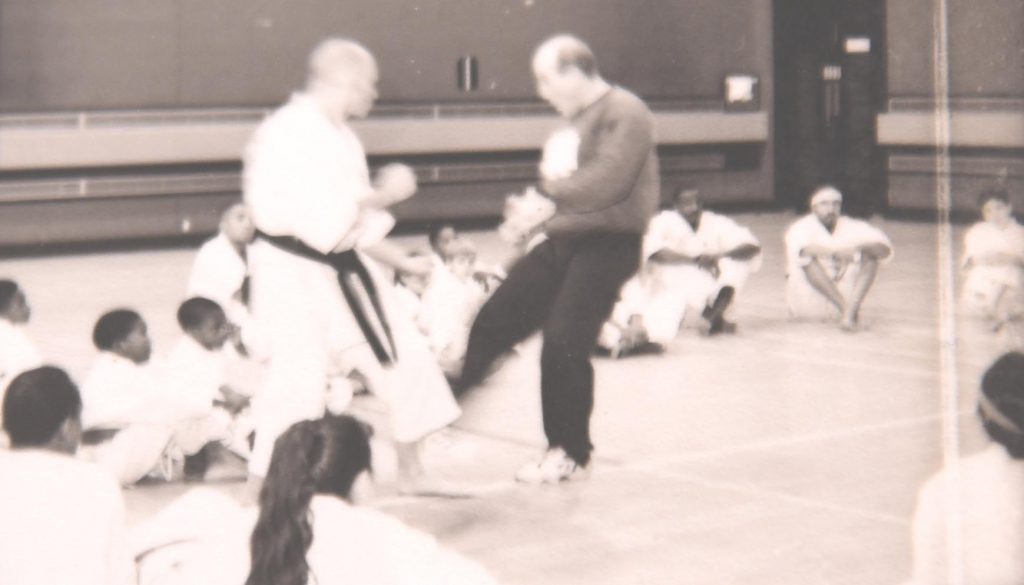
After the break of 15mins Dr Steven Bellamy then gave an explanation on cross planes attacking and PNF stretching.
Cross planes: attacking your partners on different planes as Steven called it “overloading your opponent’s ability to react”. Mr Roy Watkins and Suilman Bakaya were called to demonstrate, Suilman attacked Roy on one level with various techniques with speed and power, Roy was allowed only to block or evade which he did with ease. Steven then stepped in against Roy, and asked him to block or evade, Steven then attacked Roy using the cross plane theory, attaching vertical, high, low, to the side and circular. Roy apart from the first technique was a sitting duck (Roy a couple of years ago the runner up to Ronnie Christopher at KUGB nationals). We then were asked to pair up and practice his theory.
The second part of the lecture, was about various types of stretching, a brief explanation on Dynamic, Static and PNF and then Dr Bellamy stated the WSKF in its scientific approach recommends the PNF method, and in order to give further explanation Roy was at hand to be the fall guy again. Roy was asked to sit comfortable against a wall and two students were called on to assist. Roy was asked to spread his legs to his maxim (box splits) each assistant was asked to hold each leg in position and Roy was asked to try and close his legs by pushing against the assistants, and as soon as he stopped pushing and relaxed, the assistants moved his legs further apart without causing any discomfort to him, then he was asked to push again and as soon as he stopped pushing his legs were moved back further, this was done about four times. Roy was amazed at the increase in his flexibility, Dr Bellamy pointed out this must be done very careful one could increase one’s flexibility by about 30%. This type of stretching is based on the “Golgi Reaction”.
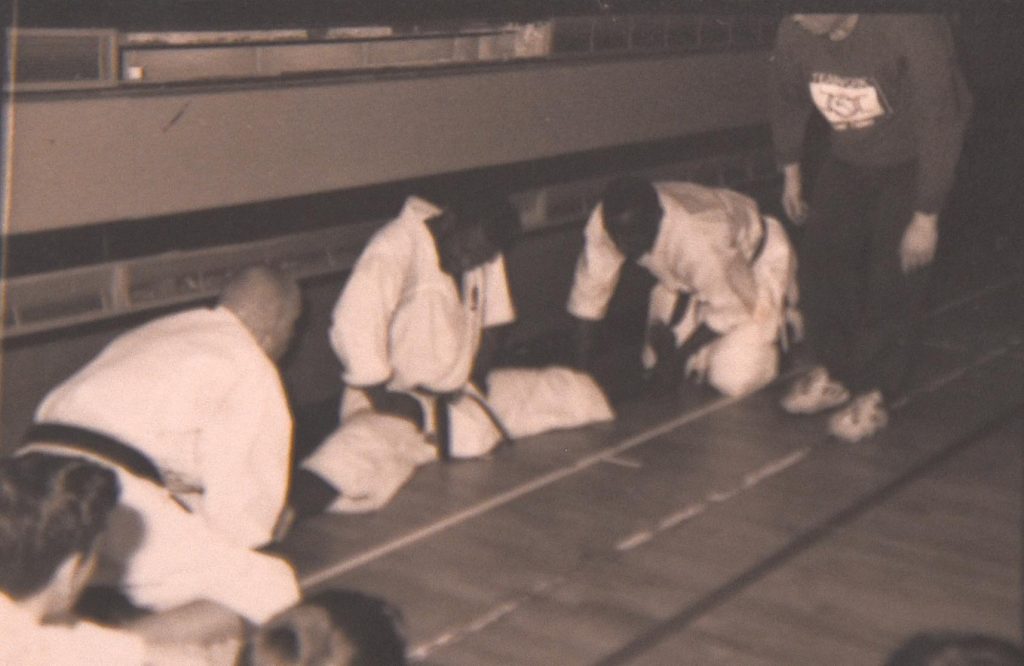
Doctor Bellamy supervising the “Goigi Reaction”
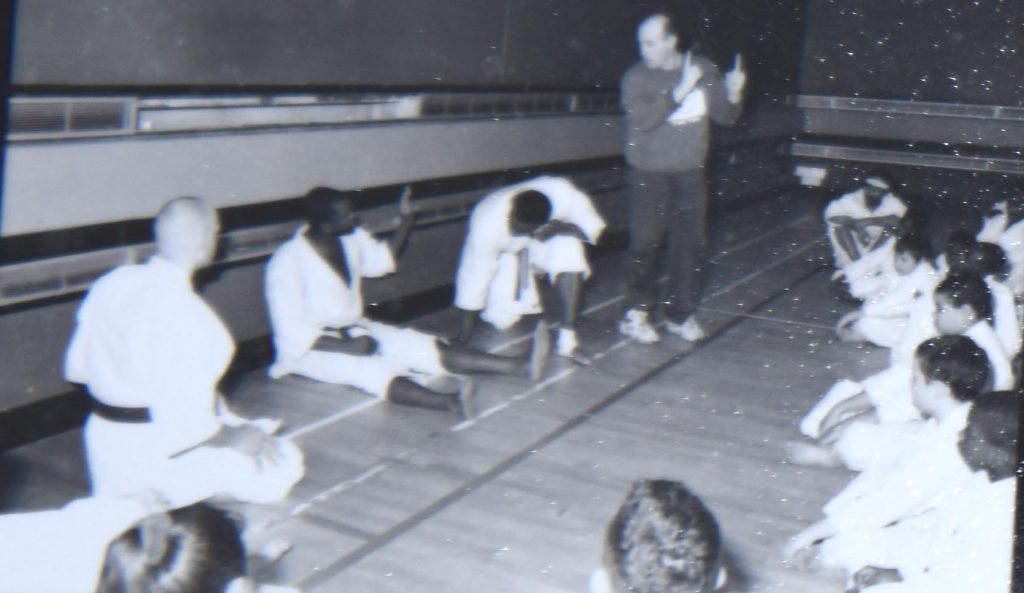
Doctor Bellamy and Roy Watkins sensei confirming the improvement
Tomiko Mitsuoka Sensei then took over for the last sessions Bassai dai, Sochin and Unsu, the interval method also applied during the kata session.
Mitsuoka Sensei came 3rd in Kata at the 1985 World Championships and three times World Team Kata Champion, competed in the JKA and SKI at the top level, before moving to the WSKF about five years ago.
Bassi dai – emphasise on twisting the hips sharply during the blocks and the position of the head during the Kata.
Unsu – emphasise to keep the hips low and to keep the elbows and arms close to the body at all times, the further away your limps are from your body the less kime can be generated, the correct angle of the hands and arms were shown and explained plus the stepping forward in neko ashi dachi
Sochin – emphasise on keeping the hips low especially during the side snap kick and the front kick at the end. It was explained that each katas has a “theme” and this should be indicated during the performance of the kata, Sochin kata should have big circle moments, the flow of the kata must be calm and then dynamic with very strong stances, the upper body must move with the lower body.
After practising Sochin a few times, Sense invited Dr Bellamy to give the last lecture for the brown and black belts so they can improve their performance of karate. A brown belt student (Carl Kemmin) was asked to remember the best time of his life, as he did a big smile came over his face, he was then asked to look in front of him and drawing an imaginary circle, this circle will be called the circle of excellency and every time he steps into this circle he must tap his wrist and remember that feeling and then perform his kata. Dr Bellamy stated that if you feel great or depressed your karate will reflect this, you must run your brain and do not let your brain run you, and remember your body will not go where your mind has not been. We then were asked to practice the circle of excellency theory and then we practised Sochin a few more times using the circle of excellency philosophy.
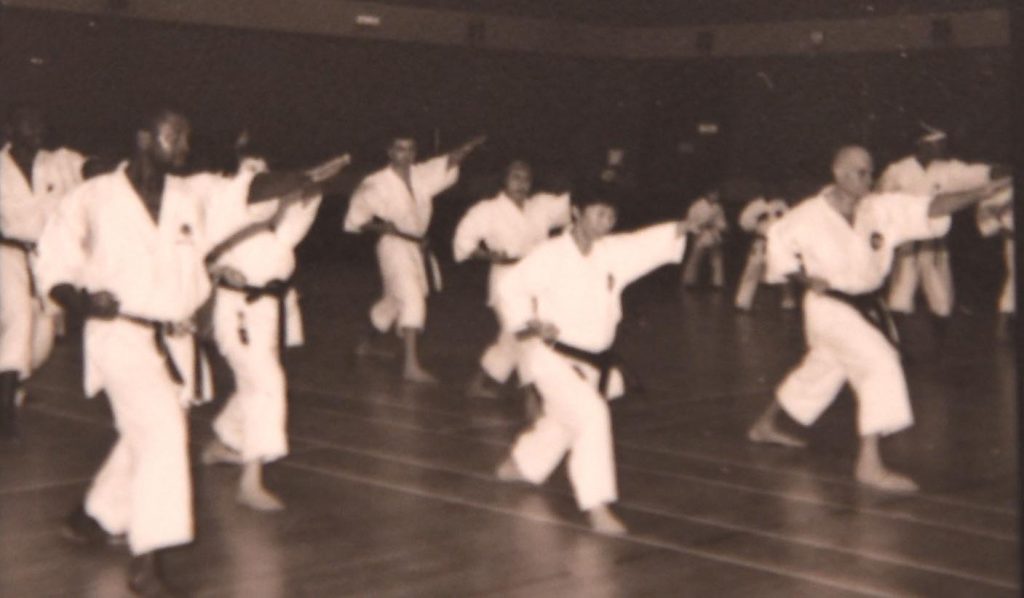
Tomiko Sensei Leading the Class from the front
Tomiko Sensei Teaching and Leading from the front
Just to finish off, Dr Bellamy taught the class some warming down exercises, which included stretching our backs and manipulating our feet. We were told that most students compress their bodies while performing karate techniques, hence a good stretch after a hard session is necessary.
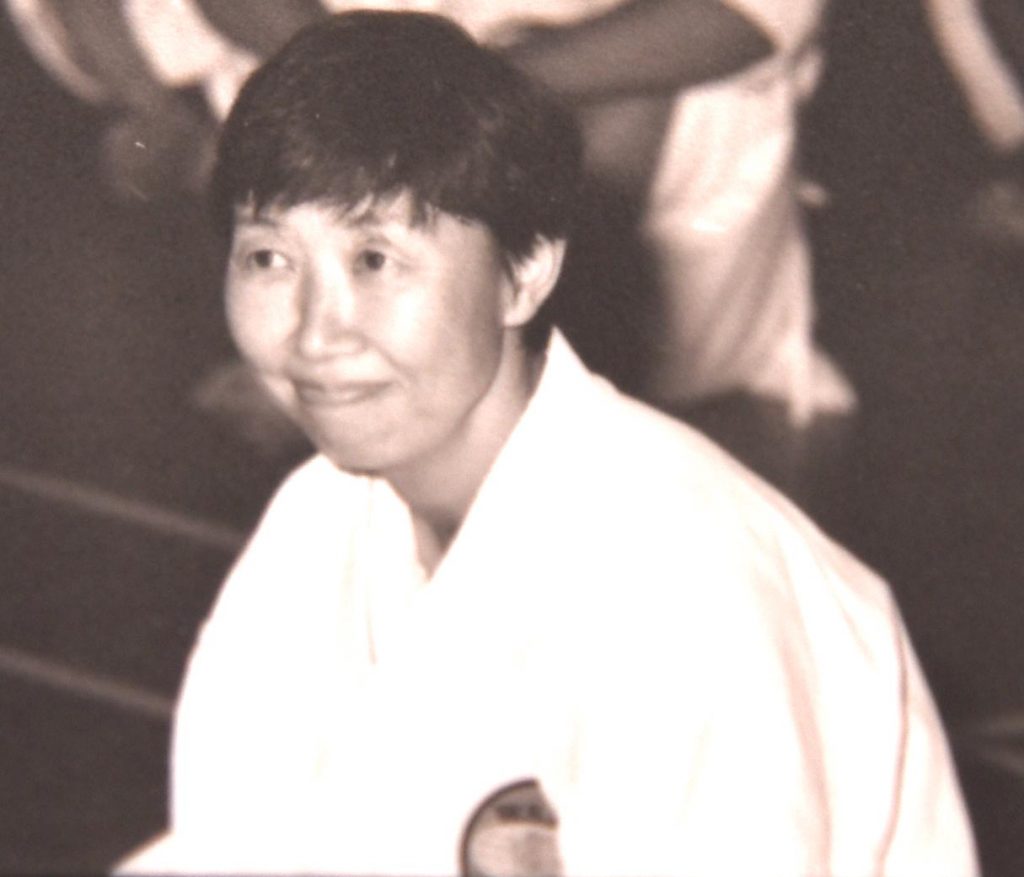
Tomiko Sensei at the end of the seminar
The course was brought to an end with both Instructors thanking all the students that attended Mitsuoka Sensei stated that this was an WSKF Open Course with no political implication, and there will be further courses in the London area in future and they hope to see them all again
